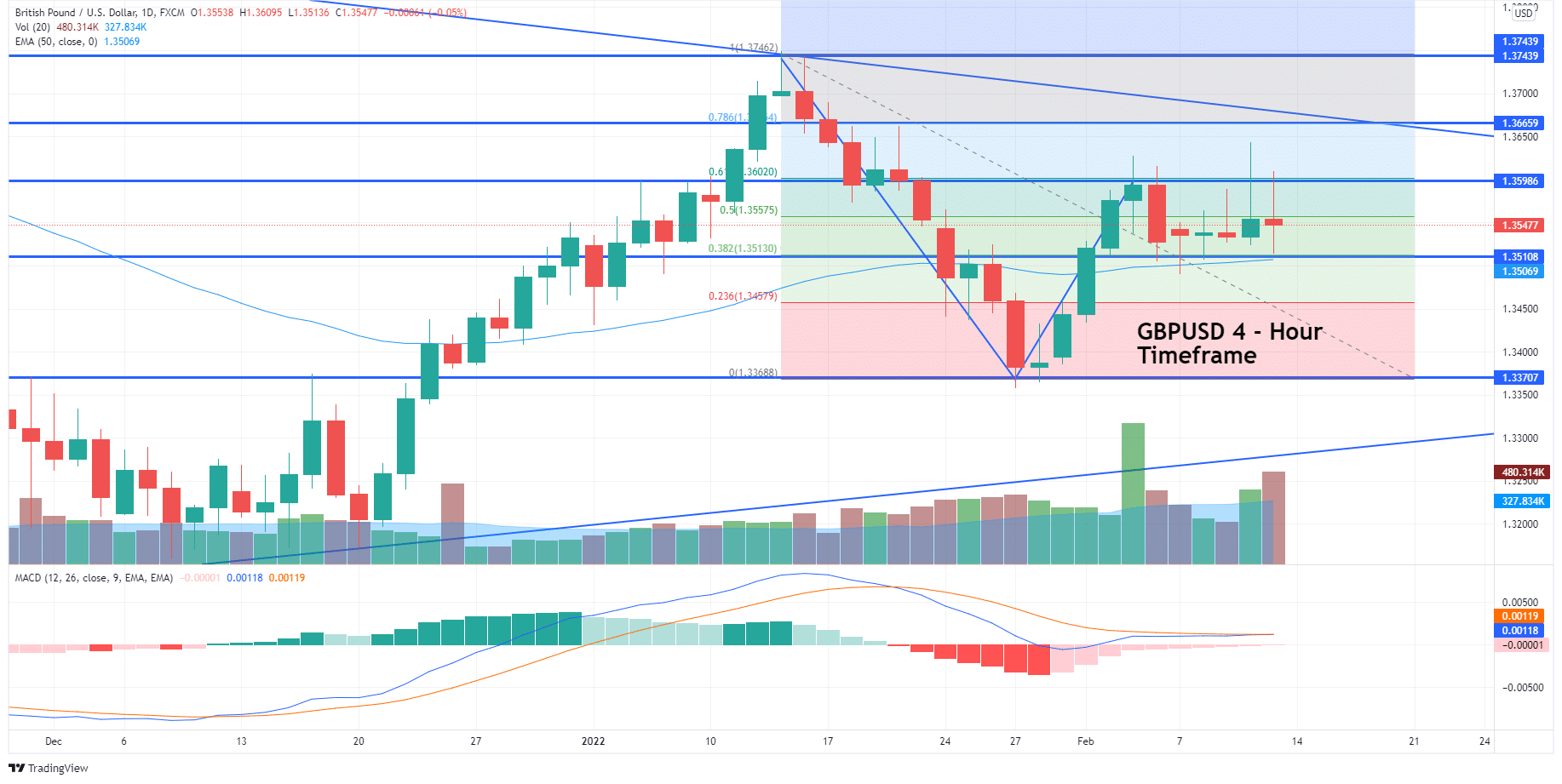GBP/USD Steady at $1.3545: Traders to Eye on UK Inflation Data
Please note that we are not authorised to provide any investment advice. The content on this page is for information purposes only.
- Data being out next week will be critical in evaluating whether the Bank of England tightens its projections for 2022.
- Economists are expecting a steady UK CPI rate of 5.4 percent versus 5.4 percent beforehand.
- A surge in demand may push the GBP/USD price up to the next resistance level of 1.3598 or 1.3665.
The GBP/USD closed on Friday with a 0.2 percent gain, making it one of the best performing G10 currencies on the day. That was followed by better-than-expected Q4 GDP and December activity statistics released during early European trade. The pair’s upside appears to have peaked at the 1.3600 level as FX flows slowly in preparation for the weekend. Although GBP/USD is still trading about 100 pips higher from previous session lows well above 1.3500.
BoE Hawkish Stance Boost GBP Demand
Data being out next week will be critical in evaluating whether the Bank of England tightens its projections for 2022. Currently, almost a further 150bps of tightening is expected. During the week ahead, the most recent labor market statistics will be available. That will be giving market players a first look at how the UK labor market fared during the rapid spread of Omicron. The January CPI will be revealed on Wednesday, followed by Friday’s January Retail Sales numbers.
What to expect from BoE?
Stronger-than-expected data next week is unlikely to boost the BoE’s tightening expectations to be any more hawkish than they already are. Indeed, many analysts believe the Bank of England will provide substantially less tightening in 2022 than is now priced into money markets. The economy is expected to face repeated speed bumps beginning in Q2. These include tax increases, energy price increases, and the risk of rising borrowing costs, which may deter the Bank of England from tightening as aggressively in H2. That’s because of the fact, inflation levels fall below the more than 7.0 percent levels projected in April.
US FOMC Meeting Minutes in Highlights
The US schedule is dominated by Fed speech and meeting minutes and January Retail Sales and Producer Price Inflation. GBP/USD may remain volatile as investors assess the prospects for BoE/Fed policy divergence, as well as how recent data/central bank releases (and commentary) influence this outlook. Technicians will look for support between 1.3500 and resistance near 1.3600-1.3650.
GBP/USD Supported Despite Stronger US Inflation Figures
The annual inflation rate in the United States increased to 7.5 percent in January 2022. That’s the most since February 1982 and significantly higher than market predictions of 7.3 percent. Surging energy costs, labor shortages, and supply disruptions combined with robust demand weighed.
- Energy continued to be the largest contribution (27 percent vs. 29.3 percent in December), with gasoline costs increasing by 40% (49.6 percent in December).
- Inflation accelerated for shelter (4.4 percent vs 4.1 percent); food (7 percent vs 6.3 percent), specifical food at home (7.4 percent vs 6.5 percent)
- New vehicles (12.2 percent vs 11.8 percent); used cars and trucks (40.5 percent vs 37.3 percent); and medical care services (40.5 percent vs 37.3 percent) (2.7 percent vs 2.5 percent ).
- With volatile energy and food categories excluded, the CPI increased by 6%, the largest since August 1982.
- Consumer prices grew 0.6 percent on a monthly basis, as predicted.
UK Inflation Figures – Wednesday, Feb 16
Annual inflation in the United Kingdom increased to 5.4 percent in December 2021. That’s up from 5.1 percent in November, and above market expectations of 5.2 percent. It is the highest reading since March 1992. Indicating that inflationary pressures remain, owing to rising energy prices, supply chain disruptions, and a low base effect from the previous year.
- The cost of food and non-alcoholic beverages (4.2 percent vs. 2.5 percent).
- Restaurants and hotels (6 percent vs. 6.2 percent).
- Furniture and household goods (7.3 percent vs. 6.1 percent).
- Clothing and footwear (4.2 percent vs. 2.5 percent) contributed the most to the increase (4.2 percent vs 3.5 percent ).
- On the other hand, there was a slowdown in the cost of transportation (11.9 percent vs 12.5 percent).
- Recreation and culture (11.9 percent vs 12.5 percent) (3 percent vs 3.3 percent ).
Consumer prices increased 0.5 percent on a monthly basis, following a 0.7 percent increase in November. Economists are expecting a steady UK CPI rate of 5.4 percent versus 5.4 percent beforehand. Thus, GBP/USD may remain supported.

GBP/USD Price Analysis – Technical Outlook
The GBP/USD fell below 1.3600 during the overnight session for fundamental reasons, losing more than 100 pips. The drop, however, was halted at the 100-day moving average (DMA). It does, however, form a bearish-engulfing candle, indicating a leg down before consolidating.
The first support level to be tested for the GBP/USD will be the confluence of the 100-day moving average and the 38.2 percent Fibo retracement, which will be located around the 1.3507-20 range. If the latter is breached, the pair is likely to fall to the confluence of the 50-DMA and the 50% Fibonacci retracement around 1.3433-55, followed by the 61.8 percent Fibonacci retracement at 1.3381.
A surge in demand may push the GBP/USD price up to the next resistance level of 1.3598 or 1.3665. However, the pair has formed a “bearish engulfing candle,” indicating that the selling trend is likely to continue. As a result, the bias is down under the 1.3520 level, with a target of 1.3450, and vice versa.
Good luck, and stay tuned for more updates!





